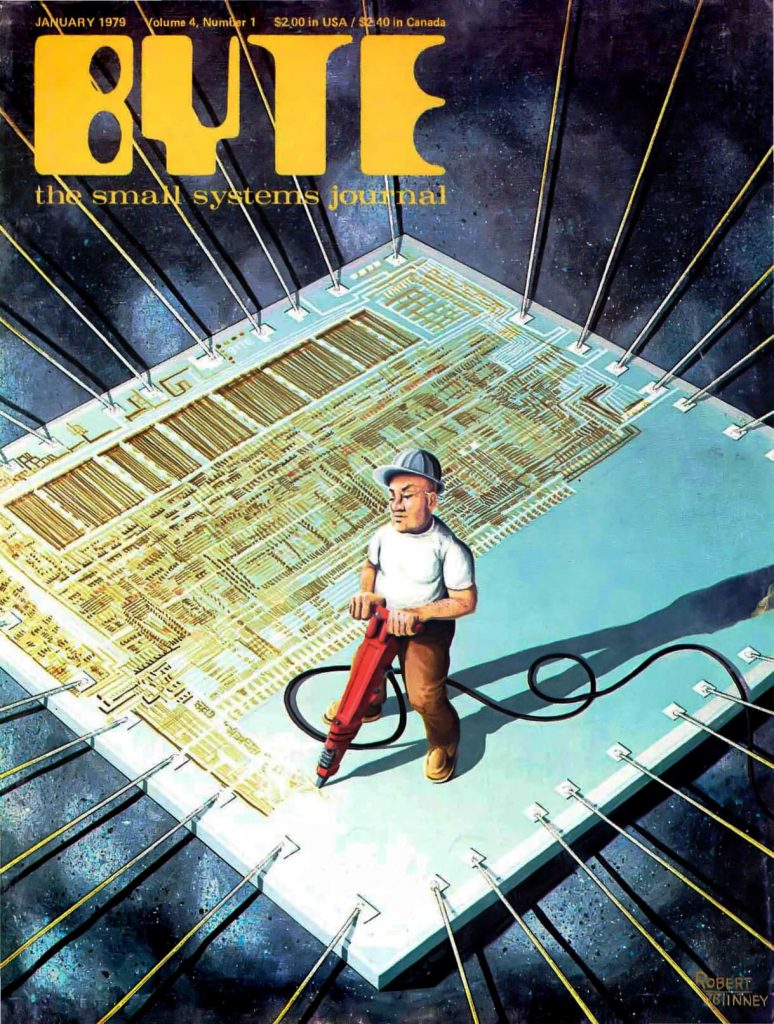Source: Byte – January 1979
In 1979, you had to be into computers in a serious way to own one for your home. They were expensive, laughably underpowered by today’s standards, and in most cases you had to build them yourself, including soldering the chips on the motherboard. Some businesses had computers but even that was relatively rare. The evolving standard at the time was 8080 or Z80 CPU based machine with an S100 bus for expansion and 64K of RAM or less running the CP/M operating system. There was still a lot of variety outside of that though. The January 1979 issue of Byte includes:
Foreground
- Build a Computer Controlled Security System For Your Home – Part one of a series on building a home security system based around the Intel SDK-85 single board computer.
- A computerized Mailing List – A series of type-in BASIC programs for managing a mailing list.
- Life Algorithms – Some algorithms are provided here in a pseudo-language resembling ALGOL based on Conway’s game of Life.
- Polyphony Made Easy – A guide for interfacing a (music) keyboard to a computer that allows multiple notes to be played at once.
- An Audible Logic Test Probe – A guide to building a logic probe that outputs one tone for a high logic level and another for a low logic level and also includes two LEDs for monitoring single pulses and pulse trains.
- History of Computers: The IBM 704 – A detailed look at the IBM 704. This “data processing system” was announced in 1956 and was one of the last vacuum tube computers.
Background
- A Microprocessor for the Revolution: The 6809 – Part one of a series on the Motorola 6809 microprocessor. This part covers the design philosophy. The 6809 was one of the most advanced 8-bit processors but also one oft he most expensive. It found its way into some home computers like the TRS-80 Color Computer and arcade games like Star Wars, Defender, Joust and Robotron. However, its high expense led to the design of the inexpensive 6502.
- An Exposure to MUMPS – A detailed look at the Massachusetts General Hospital Utility MultiProgramming System.
- The Digicast System: Receiving Data and Information Over Your FM Radio – A proposed way that computer data could be sent via FM radio. As far as I know, this was never implemented.
- Grandmaster Walter Browne Versus Chess 4.6 – An early human vs. computer chess match.
- An Introduction to BNF – BNF is a standardized way to abbreviate computer language statements that would be used, for example, in manuals.
- Creating a Chess Player, Part 4: Strategy – The fourth part in a series on creating a computerized chess game. This part focuses on how the computer can form strategies by giving it knowledge of certain patterns.
- IPS, An Unorthodox High Level Language – A detailed look at this high level language designed for amateur radio satellites and associated ground control stations.
- Elements of Statistical Computation – Methods for calculating the mean of a set of data.
Nucleus
- A Short Note on Pascal Progress and Other Topics – A plan for making Pascal available on the Apple II.
- Letters – Letters from readers about computer insurance, Tokyo computer shows, using a DECWriter with an H8 system, and much more.
- Book Reviews – A reviews of Financial Analysis and Business Decisions on the Pocket Calculator by Jon M Smith.
- Machine Language Puzzler: Memory Meanderings – A puzzle in which the reader must figure out the operation of a given 8080 machine language program.
- Technical Forum: Comments on S-100 Bus Extension – A proposed 16-bit extension to the S-100 bus.
- BYTE’s Bits – Tips for TRS-80 owners who are upgrading memory, info on the Personal Computing Festival of the 1979 National Computer Conference, solving the eight queens problem, and more.
- Desk Top Wonder: Some Random Games – A couple of type-in games for the Texas Instruments model 58 and 59 programmable calculators.
- Nybbles: A Micro Word Processor – A type-in machine language word processor for the Z80/8080 CPU.
- Programming Quickies: Single Stepping the 8080 Processor – A type-in machine language program that will allow you to single step your way through a program. Useful for debugging.
- What’s New? – SAM76 high level language, clock board from Mountain Hardware Inc., MSBC family of video interface boards designed to work with the Intel single board computer bus, the Micro Bee 2 8085A processor controlled buffered video display terminal, 88-SAI synchronous interface board for the S-100 bus, 16-port serial board from Ohio Scientific, and much more.

…and more!


